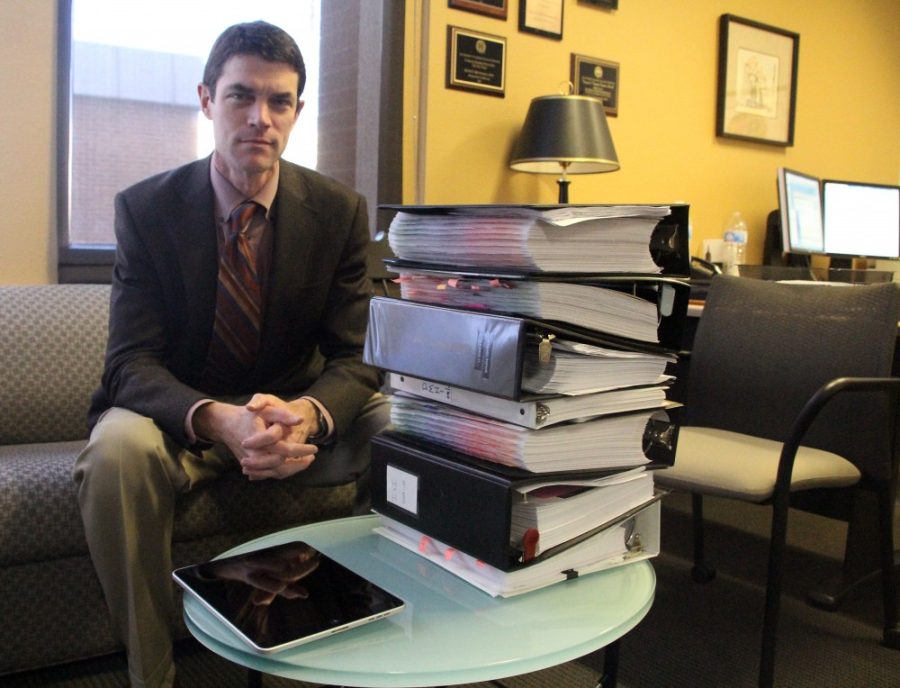The College of Medicine’s class of 2015 had the option to receive an iPad 2 or have their printed learning material paid for throughout medical school. Ninety-two percent of them took the tablets.
The ArizonaMed iPad Pilot Project will improve the way students learn and prepare them to handle the approaching paperless medical world, said Kevin Moynahan, associate professor of medicine and deputy dean of education for the College of Medicine.
“I believe that in 10 years, the College of Medicine won’t have paper,” Moynahan said. “We’re not at a paperless curriculum right now, but we have everything set up for it.”
Two types of apps will be the most useful for medical students, Moynahan said. Utility apps like note takers and communication programs allow students to organize their work and schedules. An example of medical apps helping students where print textbooks can’t is after students work with dead bodies in the cadaver lab.
“Outside of the cadaver lab, students need to study and two dimensional textbooks are very limited,” he said. “With 3D apps you can look at the cadaver from different angles, spin and label it.”
Interactivity between students and their curriculum is the key to revolutionizing the classroom, Moynahan added.
Amber Eellasiore, a medical student that chose free printing instead of the iPad, said she studies better with paper and that many students will use the tablets for Facebook instead of learning.
“School isn’t about all the shiny toys you can accumulate, it’s about how best you study,” she said. “A free iPad is cool, but for me personally, I know it wouldn’t help.”
IAnnotate was the only application that came on the iPad, said Michael Griffith, associate director of biomedical communications and project leader. The app allows users to read, annotate, and share PDF files. Many of the apps students need are free and more may be bought for students as the project is evaluated, he added.
Paul Saladino, one of the 107 medical students who chose the iPad, said it’s the only thing he brings to class. It makes note taking more effective and it’s easier than carrying “reams and reams” of papers, he said.
Other than not being able to use Flash Player on his iPad, Saladino said the tablet has no major drawbacks.
“We’re not wedded to the iPad,” Moynahan said. “We’re looking at the tablet as a medium. The iPad seemed to suit our needs the best. It has the most support and the most medical applications available.”
Through focus groups and surveys, Griffith said they will evaluate the iPad’s drawbacks, benefits and how useful they are. Assuming research supports the benefits, the project will continue next year.
The College of Medicine budgeted $90,000 for the project’s first year and $77,000 has been used so far, Griffith said. Saving money over time by reducing printing costs and helping the environment by cutting out paper from the curriculum are added benefits, but are not the main goals of the project, he added.
Griffith agreed with Moynahan and said that as students become more accustomed to technology in the classroom, the College of Medicine will be able to display the curriculum in a completely digital format. Eventually, students will look around the classroom and won’t see any paper.
“They won’t want that option anymore,” Griffith added.
Aqib Zehri, a UA alumnus, took this year off after graduating to volunteer and intern. He said he applied to the UA’s medical school, and if he’s accepted and given the option, he’d choose digital over printed resources.
“It makes sense because everything is becoming paperless in hospitals,” Zehri said.
Griffith said medical students need to be prepared for the electronic records they’ll be using as doctors and should take advantage of technology to learn more efficiently.
“We’re trying to make the best doctors we can for Arizona,” Griffith said. “Everything that we’re doing is intended to make our students better doctors, not iPad experts.”









